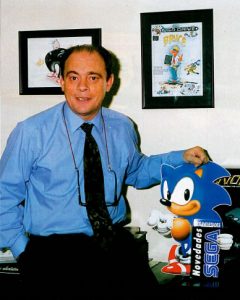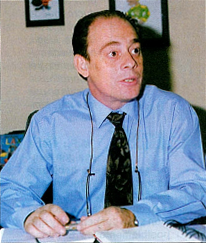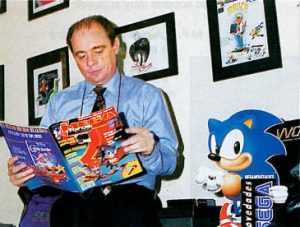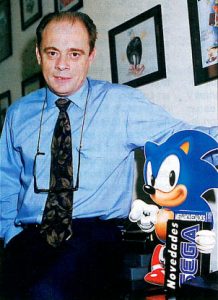This interview originally appeared in the November 1992 issue of the Spanish video game magazine Mega Force. In it, the head of Sega’s Spanish division, Paco Pastor, shares some candid opinions on Sega’s products at a time when the company’s European fortunes were on the rise, particularly the Mega CD and the Game Gear. It’s an interesting glimpse into how Sega ran its business in Spain, a sector that doesn’t usually get much press.

Before his time in gaming, Pastor had a successful career in music in the 1970s. He was the lead singer of the pop group Formula V, later taking on a role as an artistic director a CBS. He never had any interest in gaming until he went to a friend’s house one summer and saw some kids play a Commodore Vic 20. He was impressed at how they entered commands into the keyboard to make shapes and colors appear onscreen. On subsequent business trips to London, Pastor noticed that game packaging was much more elaborate and artistic than what was sold in Spain. He felt that game sellers in his country could do a lot better at making their wares more attractive.
Pastor founded Erbe Software in 1984 together with Peter Bagney, and the company became one of the most important video game distributors in Spain during the ‘80s and early ‘90s. Its success led Pastor and Bagney to found Topo Soft, a subsidiary of Erbe and one of the most important Spanish video game producers of the golden age of Spanish software. Eventually, Pastor’s company controlled 80% of game distribution in Spain, serving around 3,000 stores. Pastor was also instrumental in tackling video game bootlegging in Spain. In less than a decade, he successfully reduced bootlegging in Spain by 90% by drastically reducing prices and selling the games directly to the bootleggers themselves in return for a commitment to honest business practices. He made up for the lower prices by dramatically increasing the volume of sales.
Later, Pastor served as an advisor to Sega from 1987 until he became its president in 1989. Pastor was a major advocate of the Mega CD, and he tried desperately to get its price reduced in Spain. He convinced the head of Sega Europe, Nick Alexander of the need for a lower price point, and went as far as traveling to Japan to make his pitch to Sega CEO Hayao Nakayama personally. “I went to Japan myself and told him two things that I thought needed improvement,” he later explained. “The first was that the older consoles should not be killed off when a new one came out, as happened with Master System and [later] Mega Drive. The other, the price.” He also suggested that older games be ported to the Mega CD, but Nakayama reportedly disagreed because they would not demonstrate the new machine’s capabilities. No agreement was reached, and Pastor left, frustrated.
The Mega CD’s subsequent failure disillusioned him further. Pastor left Sega in 1993 and returned to music, where he continues to perform and tour.
* * *
It’s possible that Paco Pastor and Sega are one and the same. The true motor of revolution in our country, this video game veteran (he was already involved in the early ‘80s) apparently has no limits to his goals.
Sega has strongly penetrated the Spanish market. With more than 265,000 consoles and 700,000 cartridges sold last year, the company can look to the future with great optimism. Paco Pastor, head of the Spanish branch, tells us about the many plans his company has for the next few months and reminds us that when we think of Sega, we have to consider a company that operates on two levels: on the one had are its consoles, and on the other are its games.
 Paco Pastor: This Christmas, a bunch of new games are coming out. For example, the most important are Sonic 2, Batman Returns (based on the film), Mickey and Donald… a Lemmings game for the Mega Drive. Streets of Rage 2 is coming. We’re working on a tennis game staring Andrea Gassi (the current tennis champion). It’s impressive; I saw it a few days ago and it left me completely awed. There’s another game called Dolphin, that has awesome graphics and a dolphin hero. And if the graphics are incredible, the control is even better. With Disney, we’re preparing TaleSpin and Ariel [The Little Mermaid].
Paco Pastor: This Christmas, a bunch of new games are coming out. For example, the most important are Sonic 2, Batman Returns (based on the film), Mickey and Donald… a Lemmings game for the Mega Drive. Streets of Rage 2 is coming. We’re working on a tennis game staring Andrea Gassi (the current tennis champion). It’s impressive; I saw it a few days ago and it left me completely awed. There’s another game called Dolphin, that has awesome graphics and a dolphin hero. And if the graphics are incredible, the control is even better. With Disney, we’re preparing TaleSpin and Ariel [The Little Mermaid].
The Menacer will also be available with a six-pack of games for 9,900 Ptas [Pesetas, the former Spanish currency]. It will be an extraordinarily inexpensive accessory, and since it includes six games it’s even more attractive a buy. The Menacer has a special feature in that in converts into three different configurations – we could say that you’re buying three different features for the price of one. It can be used as a pistol, a machine gun, and as a bazooka with a shoulder stock.
Our new hardware includes the CD-ROM that we’re going to launch strongly next May because we want to release it at a much more accessible price than it has now and with some great games. Sega has always been characterized for the quality of its games; it’s the #1 manufacturer of amusement machines, and from that technical and game-making know-how we began making home consoles. Sega has to come out with a software selection for the CD-ROM that is absolutely mind-blowing. It’s not enough to have the best graphics and sound on the standard Mega Drive – that’s a given! We have to have something totally amazing, and that we saw that “amazing something” at a Sega Europe meeting in London. Companies of Sony’s stature are developing a series of games that are truly movie-like in quality.
Mega Force: So the Mega-CD will be in stores this Christmas?
Paco Pastor: I think we’re going to have only a few, just so people know that it’s out there, that it exists. The launch is going to be in May with a library of software and superior support.
Mega Force: What will be the launch price?
Paco Pastor: We’re still not sure, but we want to sell it for less than 34,000 Ptas with three discs (it will launch in the U.S. this Christmas for $299, or 30,000 Ptas). Ours will include two games and a disc with previews of all available games. The two games will probably be Sherlock Holmes and a special Mega CD version of Sonic 2.
Mega Force: It looks like only one disc will have special versions in different languages. Will it be possible to play games in Spanish?
Paco Pastor: That’s one of the problems we’re working on. Almost all the software is developed in the U.S., and as everyone knows, there is a difference between there and Europe regarding the [television] frequencies used. So, there should be a localization process, which is why the Mega CD will come out in the U.S. at the end of November and we’re waiting to go all-out with its release in May.
Mega Force: But all of that had already been announced in some way. Does Sega have some special, revolutionary product coming?

Paco Pastor: Well… we’re working on a 32-bit console, but there isn’t any confirmed information yet. It could be launched in 1994, but there’s still a lot of time and development is still in its early stages.
Mega Force: People have been talking about the JVC WonderMega for some time. Some say its production has been suspended and that its remaining stock will be liquidated. Is there any truth to any of that?
Paco Pastor: As far as I know, production hasn’t ceased. What’s happened is that it’s been promoted through JVC’s own network, and there still aren’t any release plans or a date in Europe. We’ll see what happens in the next few months.
Mega Force: Another product that may appear soon in Europe is the Mega PC, developed by Amstrad in collaboration with Sega. What can you tell us about it?
Paco Pastor: It’s the same situation we have with the WonderMega. The Mega PC is a product that isn’t manufactured by Sega and that won’t be, at first, at least, in our catalog. Regardless, we’re hoping to see some units in British stores this Christmas and that the price is sufficiently adjusted to be attractive.
It’s clear though, that the Mega PC user is not exactly the same as the Sega console owner. It’s possible that buyers will look for a general use device that has the added bonus of being compatible with all Mega Drive games without any issues.
Mega Force: JVC, Amstrad, in its day IBM… It seems that Sega has a good collaboration policy with other companies. Is Sega thinking about any other “partnership?”
Paco Pastor: Well, it’s true. Right now, I’d say that our most important partnership is with Sony, which I think is a very interesting one. You know Sony is a dragon with many heads: it has its RCA studios, Sony Music or CBS… Additionally, this partnership guarantees what Sega has always looked for: to work with a company that could provide technical development, and that is precisely what Sony has. That said, it’s a two-way partnership. It isn’t just about giving another company a license to manufacture something Sega’s already made. Imagine what it would be like to have all the Indiana Jones movies in video game form on the Mega CD!
Mega Force: Sega has had some bad experiences with peripherals. For example, some time ago there wee some special glasses for the Master System that lost relevance over time and that can’t ever be played by owners of the Master System II because they connected to the card port that was eliminated with the new hardware revision. Is it possible that yet another Sega peripheral could be abandoned?
Paco Pastor: No. Actually, in talking about the glasses, you’re going back to what is truly ancient history. Also, when Sega came to Spain, it had already been out for two years – and selling quite well, mind you – in Great Britain and France. So, when we finally got to sell it in Spain, it was already on its way out of our catalog in those countries.
Moreover, those glasses had a problem that reflected the total pioneering spirit of that time and the reason why they were discontinued. It seems that no one considered the possibility of the glasses malfunctioning and that to fix them, they’d have to be opened up. The issue comes from the fact that when the glasses were designed, they didn’t include any screws. There was no way to get inside them without separating the sealed plastic pieces, breaking them in the process. Logically, it became clear that it was a dumb idea and the decision was made to discontinue them. Still, the Master System light gun continues to sell well, and we’re still making games for it.
In fact, we keep producing and promoting the Master System in Europe. It’s the best-selling console in Spain and one of the best-selling in Europe. I’m convinced that it’s the console that most people start with. With its price – 9,000 Ptas with a pack-in game – its cheaper than a monochrome handheld.
 An important thing to remember is that all of Sega’s new products are absolutely compatible with existing hardware, not like with other manufacturers. If someone has a Master System, they won’t be stuck with the games they bought for it because the Mega Drive has the necessary adapter for them to play all their games on it without issues. The same goes for the Game Gear, and the same will be true for the Mega CD, which will have an adapter for Master System games. Sega’s loyalty to its users is absolute, something that can’t be said about any other manufacturer.
An important thing to remember is that all of Sega’s new products are absolutely compatible with existing hardware, not like with other manufacturers. If someone has a Master System, they won’t be stuck with the games they bought for it because the Mega Drive has the necessary adapter for them to play all their games on it without issues. The same goes for the Game Gear, and the same will be true for the Mega CD, which will have an adapter for Master System games. Sega’s loyalty to its users is absolute, something that can’t be said about any other manufacturer.
Mega Force: Game Gear – for general consumption or a luxury?
Paco Pastor: It’s never been our philosophy that the Game Gear was a product for general consumption. The Game Gear, by concept, is not designed to be a product for general consumption. It’s a product for a more “enlightened” public, not the consumer who follows trends in the portable market. The phenomenon of the portable console is one of trends, a phenomenon of the masses. The Game Gear is absolutely not a large scale sale, and it can’t be part of that trend for many reasons, starting with its price. All of this makes the demand much more selective, more educated, and at a higher level. The product itself becomes a premium choice within the market.

Recent Comments